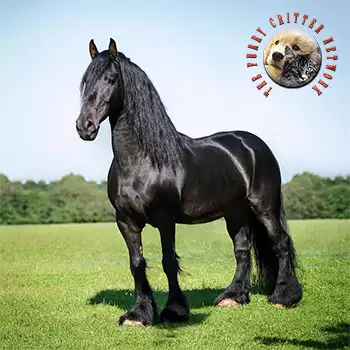History
The Friesian Horse originated in Friesland, one of twelve provinces of the Kingdom of the Netherlands (Holland), situated in the northwest of Europe. Friesland is an old country dating to 500 B.C., when the Friesians settled along the cost of the North Sea. They were tradesmen, seafarers, farmers and horse breeders.
The Friesian horse descends from the Equus robustus. During the 16th and 17th centuries, but probably also earlier, Arabian blood was introduced, especially through Andalusian horses from Spain. This has given them the high knee-action, the small head and the craning neck.
Behavior
Because of his temperament the Friesian horse is considered warm blooded. The Friesian horse has been kept free from influence of the English Thoroughbred. During the last two centuries it has been bred pure. Breeding horses and dealing in them was very important for the Friesians. The monks in the many monasteries in Friesland before the reformation did a lot of horse breeding. Through the centuries the Friesian Government has made many regulations in order to safeguard good breeding. Now the Dutch Horselaw of 1939 (modified) gives rules for studbook and breeding.
From records of the past we know that the Friesian horse of old was famous. There is information from as early as 1251 and there are books in which Friesian horses were mentioned and praised from as early as the 16th century.
Armored knights of old found this horse very desirable, having the strength to carry great weight into battle and still maneuver quickly. Later, its suppleness and agility made the breed much sought after for use in riding schools in Paris and Spain during the 15th and 16th centuries. Before an elegant carriage this breed has few rivals, and throughout Europe the royal courts used them as coach horses.
An excellent trotter, the Friesian was used for racing short distances in Holland, the winners being awarded silver or golden whips. Today in Friesland there are may carriage events and often the sjees, the Friesian form of the chaise,are seen. This unique two-wheeled cart may be drawn by one or two horses, and aboard are a gentleman and a lady dressed in the traditional costumes of the 1880s. The sjees is one of the few carriages in which the driver is seated on the left; his lady occupies the right-hand side, the place of honor. Four-in-hand carriages are common and as many as ten-in-hand can be seen in front of light carriages. These large, unusual hitches used for demonstration purposes are becoming very popular. The Friesian people take great pride in the natural ability of their black horse in harness.
The well-known English writer on horses, Anthony Dent, and others are of the opinion that the Friesian horse influenced the Old English Black Horse and the Fell Pony. Dent proposes that the Norwegian Døle (Gudbrandsdal horse), which shows great likeness to the Friesian horse, must have got there from Friesland either as booty or by regular trade. The Northern Swedish horse was greatly influenced by the Norwegian Døle. Dent also suggests a Norwegian influence on the English Dale pony. In the Pyrenees in southern France there is a pony "Ariege called after Merens" (Ariege dit de Merens) that looks remarkably like a small Friesian horse. The resemblance of the types mentioned can be traced back in some cases to the influence of Friesian horses, in other cases the similar way of breeding will have caused the similarity.
As early as 1625 Friesian horses were being imported into what later would become the United States of America. The Dutch founded New Amsterdam in the region they discovered in 1609, but they had to abandon it to the English in 1664, when the name was changed to New York. Advertisements in the papers offer trotters of "Dutch" descent. These must have been Friesian horses. The able writer Jeanne Mellin proposes in her books The Morgan Horse (1961) and The Morgan Horse Handbook (1973) the possibility that this well-known American horse is of Friesian descent. The ability to trot fast, the heavy manes, the long rich tail and the fetlocks at the feet of the original forefather of this breed may be an indication.
The breed was totally lost in North America due to crossbreeding. Tom Hannon of Canton, Ohio did not reintroduce the horse to North America until 1974. By 1983 the popularity of the Friesian in America had grown enough to support a national association and a national show.
With the help of the Friesian Studbook Friesian horses have been imported into Western Germany, Scotland and South Africa (1957-58). The imports into South Africa occurred to improve the type of horse called the Flemish Horse, imported long ago from Belgium. Nowadays this type of horse is not found in Belgium anymore, except when imported from Friesland.
Function
The Friesian horse today is used both in harness and under saddle, particularly in the discipline of dressage. In harness, they are used for competitive and recreational driving, both singly and in teams. A traditional carriage seen in some events designed for Friesian horses is a high-wheeled cart called a sjees. Friesians are also used in ventures such as pulling vintage carriages at assorted ceremonial events.
Health
No breed specific health issues.






